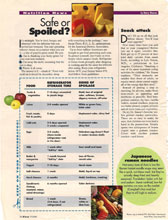Safe or Spoiled?
It’s midnight. You’re tired, hungry and obsessed with the delicious brie you served last weekend. You start spreading leftover cheese on a cracker when you see it—a line of grayish-green mold. Do you:
A. Eat it, thanking your lucky genes for your cast-iron stomach?
B. Cut away the mold, reasoning that the rest is okay?
C. Throw it all way?
The answer is C—chuck it! “Food with mold on it should be discarded, along with everything in the package,” says Susan Thom, RD, LD, spokesperson for the American Dietetic Association.
Up to three million Americans are thought to get food poisoning each year. To protect yourself, don’t taste or even deeply inhale suspect foods. Refrigerate or freeze foods promptly after shopping or cooking and do the same for leftovers after eating. Keep your refrigerator below 40 degrees F, your freezer below 0 degrees F. And follow these guidelines:
| Food | Refrigerator Storage Time | Signs of Spoilage |
|---|---|---|
| Fruits & vegetables | 7-14 days unwashed in plastic bags | Mold, loss of original color, softness, bruises, slippery texture, off color |
| Juices | 2-4 weeks opened | White or green fuzz, bitter odor |
| Fresh meats, fish & poultry | 2 days | Unpleasant odor, slimy feel |
| Cold cuts | 3-5 days opened, 2 weeks unopened | Unpleasant odor, slimy feel |
| Eggs | 3-4 weeks (store inside refrigerator—not in the door) | Unbroken egg doesn’t float in water; broken shells |
| Milk | 1 week after the "sell-by" date | Sour smell & taste |
| Butter & margarine | 1 month beyond the "sell-by" date | Loss of flavor; rancid odor |
| Yogurt | 7-10 days | Harsh taste |
| Soft cheeses | 1 week | Mold, liquid on top |
| Hard cheeses | 6 months | Mold, hardness, cracking |
| Condiments (ketchup, mustard, mayonnaise, salad dressings) | 6 months opened | Color darkens |
| Bread | 1 week (2-4 days if not refrigerated) | Green, white or blue fuzz |
